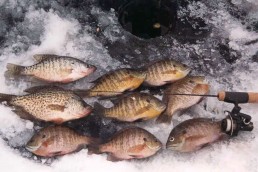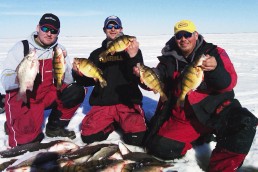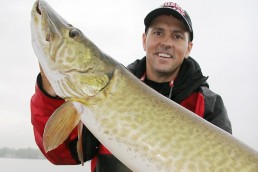Try Vertical Tactics for Early Perch and Crappies
SHARE THIS POST
Where are panfish found after the ice goes out? Well…on the Upper Great Lakes, the answer often is in deep water not far from where you last found them while ice fishing. How deep? As an example from Little Bay de Noc on far northern Lake Michigan, I often catch April perch in depths of about 25 to 40 feet. On other lakes I have found crappies suspended in deeper waters like this. A far as finding more specific areas on your chosen lake, ask local bait shops, check online reports and talk to local anglers when the opportunity arises. Out on the water, look for concentrations of boats and trust your electronics to show you schools of fish.
In this article I’ll suggest several ways to work an area after you find some marks on your electronics. They have helped me fill many stringers over the years.
Use some ‘anchor swing’
While idling through an area as you search for fish, you will eventually see marks close to bottom or suspended higher up. You may also see other anglers landing fish. I recommend having two anchors ready to use. Each should have a 100-foot rope. When you decide to stop in one spot, place one anchor out of the bow of the boat and let out about 40 to 50 feet of rope. This will cause you to swing in a slow arc if any breeze is present. You may decide to let out more rope and swing in a larger arc if you do not immediately find fish that will bite.
Ultimately you will have all one hundred feet of rope out and you will be drifting back and forth in a larger arc as the boat reacts to the breeze. If you get bit at some point in this swing, you should ease the second anchor into place from the boat’s stern. This will hold you in one spot.
Set one rod, cast another
To work these deep panfish, tie on a simple 1/8-ounce jig on a rod and lower it to within a foot of bottom. Place it in a holder and let it “work itself” as you swing back and forth with the breeze. With a second rod, cast a 3/16- or 1/4-ounce jig out and let it sink to bottom. Work it back toward the boat so its path of travel moves toward the jig you have straight over the side of the boat. Several perch often follow the jig you are working and one of them might grab the stationary bait.
If you show suspended fish they are more likely to be crappies or white bass. In this case, cast a lighter jig—1/8-ounce for example—and “swim” it in a slightly “wavy” motion through the water back to the boat toward the stationary jig. You will need to count your jig down before beginning the retrieve. Experiment with depths by waiting an eight count, a ten count, or more until you hit a depth that produces bites.
The ‘perch rig’ option
While the jig works well on your stationary rod, some anglers prefer the old two-hook perch rig straight to the side of the boat. This does allow you to use two different baits to see if fish show a preference.
Bump bottom to stir things up
With the bait you are casting, use a “bump and drag” retrieve to try to attract fish. The jig should occasionally drag on bottom to cause a small “cloud” of this silt to come up. This can be an attractor to nearby perch. It imitates the feeding movements they use when they root for wigglers or other food they find on bottom.
Are you enjoying this post?
You can be among the first to get the latest info on where to go, what to use and how to use it!
Bait selection
Some anglers have strong preferences when it comes to bait selection for early perch. Wigglers do not work too well on jigs. They are too soft and fish pull them off easily. I have other ways to use these baits, which are discussed later in this article. Pieces of nightcrawler are among my favorites, but minnows, leeches, and pieces of crayfish meat or small shrimp are all potentially good.
Panfish on plastics
While I still prefer live bait on my stationary rod, soft plastics can be a great choice for casting. So many scented varieties are now available, that you can easily find one that looks life-like on the hook. In addition, a wide variety of colors are available so you can experiment to see if one color works better than others. Many have small appendages like “legs” or “feelers” to add some natural swimming action to the plastic bait. I have generally found plastics more effective for crappies and white bass, but I’ve taken many perch with as well. In any case, plastics are always something you should have with you in case you run short of live bait.
The old “stair-step” trick
A great way to catch suspended fish in open water is one I commonly use while ice fishing. I start by holding the bait a few feet above the depth fish seem to be holding at. I use a jig or a lure like a size three Swedish Pimple. It is worked by dropping the rod tip in approximately 4-inch steps with a slight pause between steps. Each time the rod tip drops, the line should bow slightly before straightening out again. The weight of the lure pulls the line tight again at the end of each step.
At some point a fish will hit the lure as it falls, which causes the line to stay bowed. This is your sign that a fish has taken your lure. You won’t feel this bite—you’ll see it. At times this vertical presentation will trigger hits when other actions do not.
The wiggler rig
I mentioned that wigglers can be great perch baits, but they are easily pulled off the hook. I have a rig that helps catch bait robbers. Use a size three Swedish Pimple lure and tie on a 6-inch leader of clear monofilament line to the bottom of this lure. On the end of this leader, tie on a size eight short-shank hook that has a super sharp needle point.
Use this hook to impale the wiggler and set this rod in a holder. With the bait straight over the side, let the motion of the boat gently work the lure as it rocks lightly in the breeze. Because the hook is suspended on a free line below the lure, larger perch can more easily inhale the bait through the “swing” of the short leader. This helps prevent them from stealing the soft bait.
These proven presentations have helped me enjoy some great panfish action over the years. Do a little scouting this spring to help locate some potentially good areas and make these tricks work for you.
MWO
SHARE THIS POST
Did you enjoy this post?
You can be among the first to get the latest info on where to go, what to use and how to use it!
Ray Hansen
MidWest Outdoors works with more than 200 outdoor experts each year, who contribute articles based on their areas of expertise. MidWest Outdoors magazine offers more fishing and hunting articles than any other publication!



